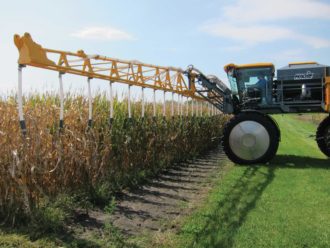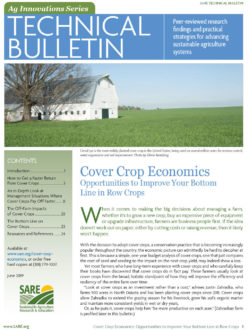Table 3 shows the typical costs of seeding cover crops. Some farmers are able to buy cover crops for as little as $5–$10 an acre if they are using common cereals such as oats, wheat or rye, and especially if the seed is available locally with no shipping costs or has been grown by the farmer. At the other end of the spectrum, for complex mixes that include pricier legumes, it is possible to spend as much as $50 per acre on cover crop seed. However, this is not typical among grain farmers when planting cover crops on large acreages. (Expensive cover crop mixes with legumes are more common on organic farms and vegetable farms.)
| Item | Cost per Acre |
| Cover crop seed | $10-$50 |
| Seeding the cover crops | $5-$18 |
| Termination | $0-$10 |
| Subtotal range | $15-$78 |
| Median cost from survey | $37 |
Likewise, the cost of seeding cover crops can really vary. If someone is hiring cover crop seed spreading, an aerial applicator may charge $12–$18 per acre, while a fertilizer dealer might charge $8–$15 per acre. If the seed is broadcast with a fall fertilizer application, the cost of seeding is basically covered as part of the fertilization cost.

If cover crop seeding is done using the farmer’s own equipment, the cost will depend on the width of seeding equipment and whether it is done as a separate trip over the field or combined with another field operation. A small 10-foot drill might have an operation cost of over $10 per acre when labor is included, while operating a 40-foot row crop planter will likely cost under $10 per acre. If broadcasting cover crop seed and lightly incorporating it with a vertical till tool, there is no extra labor or fuel cost since the vertical tillage is done anyway. However, there would be a one-time cost for modifying the tillage tool with an air seeder, which might amortize to $4–$5 per acre depending on the amount of use. In short, it is possible to buy and seed cover crops for as little as $10–$15 per acre, or to spend three to four times that amount.
The national SARE/CTIC survey showed a median seeding cost of $25 per acre in 2012. Although seed costs for some cover crop species have declined since 2012, that figure will be used for the analysis reported on here. The same survey had farmers reporting a median seeding cost of $12 per acre if they hired it out, making a total cost of $37 per acre for seeds and seeding. If the cover crop overwinters and needs to be terminated in spring, that can add an extra cost of $10–$12, but for this analysis it is assumed that a burndown spring herbicide application is being made anyway, since this is a common practice among corn and soybean farmers.
To better show how the economics of cover crops change with improvements in soil health and under special situations, tables 4 and 5 on corn and soybeans (respectively) were compiled from a variety of data sources. (See table footnotes.) The numbers are based on a combination of SARE/CTIC survey data, published input prices, research data and analysis by the authors of this bulletin. Prices shown are from spring 2019 unless otherwise noted. Where estimates were made on a few of the numbers, the goal was to be as realistic as possible based on reported farmer experiences. Some farmers report higher cost savings or greater yield increases than what is shown, but for the majority of situations, tables 4 and 5 should give an idea of approximate returns on typical corn and soybean farms.
Similar tables could be built for other summer annual crops that might be rotated with cover crops, such as cotton, sorghum or sunflowers, but less farm-based data is currently available on the yield impact of cover crops with other commodities. The authors did not attempt to do an analysis of cover crop economics for vegetables, fruits or other specialty crops but expect a similar pattern of increasing economic return would be found as soil health improves over time.
Table 4 (view | download) and Table 5 (view | download) show the impact of cover crops on farm profitability under each of the seven situations outlined in the previous section. An important thing to keep in mind when reviewing the tables is that while some farmers will have none of the seven special situations that apply to them, others will have more than one. For example, they may be grazing a cover crop while also cutting back on their use of fertilizer, or they may be getting an incentive payment while at the same time addressing a compaction issue. Thus, there is an opportunity to gain even more net profit by combining strategies or by addressing more than one yield-limiting factor in a field through use of cover crops. Again, this becomes especially true as soil health improves over time.
Another consideration is that tables 4 and 5 present information on corn and soybeans separately. Farmers are encouraged to look at their overall system and think about how cover crops fit into their crop rotations. For example, some farmers have gone back to adding a small grain into their rotation with corn and soybeans. If the small grain is winter wheat, it may be possible to either double crop beans or plant a cover crop “cocktail” mix after wheat harvest. Then the cover crop mix can be grazed in early fall and possibly again in late fall and/or spring, depending on the balance of warm season annuals and cool season annuals in the cover crop mix. Such a system may provide faster soil health benefits as well as a nice income from the grazing, but of course it depends on having access to grazing animals.
Finally, the details about how the economic assumptions were established for each cover cropping situation are captured in the table footnotes. Each farmer’s experience with cover crops will vary based on their particular situation. Readers are encouraged to substitute their own local conditions and numbers to evaluate the potential return from cover crops over time.
